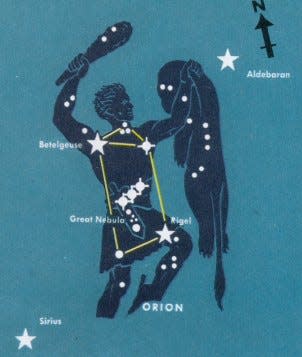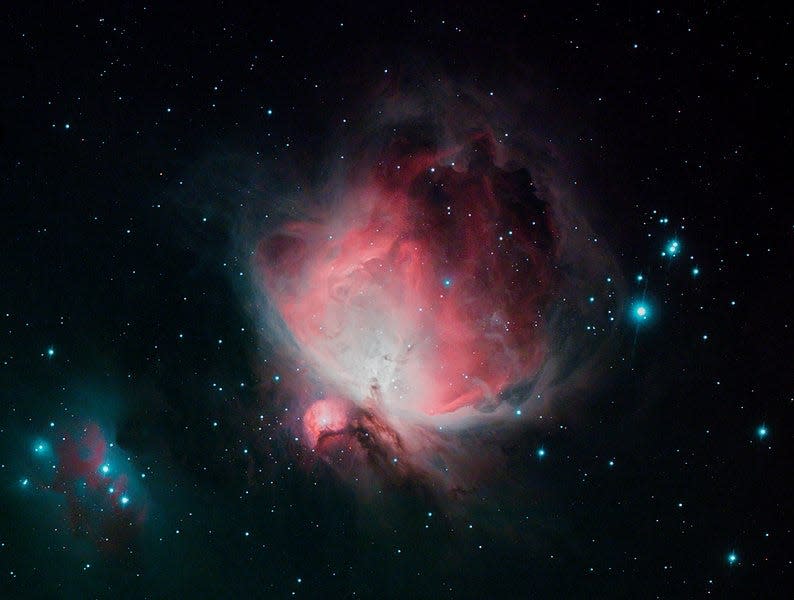LOOKING UP: Easy to find the Orion Nebula

One of the night sky's grandest sights for binocular users- as well as anyone with a telescope- is the Great Nebula of Orion. Otherwise known as M42, you can actually see this with the unaided eye as a fuzzy-appearing "star."
It is easy to find. The nebula is located within the famed "Sword of Orion", a short, roughly vertical line of stars seeming to hand from the trio of stars known as "Orion's Belt." Both are accessories eternally worn by the great mythological hunter Orion, enshrined as the brightest constellation of the winter evening.
Late December as well as January evenings are prime time to see Orion, its many bright stars glowing steadfastly in the southern sky abut half way up. Even if the Moon is bright or town lights are a problem, Orion's principal stars shine forth. Most notable are the brilliant red-orange star Betelgeuse at upper left and the glorious blue-white star Rigel at lower right. The Belt stars are right in center.
Once you have found the "Sword", examine the middle for the fuzzy patch of M42. Train any size pair of binoculars on this area for a spectacular, magnified and brightened view of the nebula and surrounding stars. Notice that there are several faint stars seemingly imbedded right in the hazy nebula.
As you look through progressively larger telescopes, you can expect to see more detail.
LOOKING UP: Andromeda Galaxy- getting closer as we speak!
To see the most of any dim celestial target such as a nebula, you should look when the sky is darkest, and with eyes that have adapted to the night. Once at the telescope eyepiece, you may see the nebula easier with a medium-power eyepiece, which tends to raise the contrast with the dark of interstellar space. Looking a bit off-center helps as well, as the side portion of the eye's retina is more sensitive to dim light.
The Great Nebula of Orion is only the brighter portion of a vast complex of interstellar dust that pervades much of the constellation Orion, revealed on long-exposure photographs. The nebula is largely made up of hydrogen and is believed to be an area where gravitational collapse leads to the formation of new stars. More than 700 stars have been detected in the nebula at various stages of formation.

The stars appearing to be imbedded as seen in binoculars or a small telescope, are part of a young star cluster. It is known as the "Trapezium" because of four stars that are spaced tightly together in a little, crooked square.
M42 is approximately 1,344 light years away.
Another remarkable nebula within Orion and part of the same, extended cosmic cloud as M42, is the Horsehead Nebula. Very difficult to see in backyard telescopes, the Horsehead has a stunning appearance of- you guessed it, a horse's head seen in silhouette. The nebula appears black, visible only because it is superimposed in front of a more distant patch of nebulosity illuminated faintly by the nearby star in Orion's Belt, Zeta Orionis.
LOOKING UP: Santa's view of the polar night sky
Many nebulas visible to backyard telescope enthusiasts have imaginative names, which are easier to remember than their catalogue number designations. Other examples include the Californsia, North America, Lagoon, Trifid, Eagle and Rosette.
COMET: New Moon is on Jan. 2. Look for the crescent Moon in the southwest evening sky after that date. Over the next few nights into the first week of January, you might be able to see Comet Leonard dimly with the unaided eyes, and much better with binoculars. About an hour after sunset, look low in the southwest, a few degrees to the left of the brilliant planet Venus.
Keeping looking up at the stars!

This article originally appeared on Tri-County Independent: One of the night sky's grandest sights for binocular users is the Great Nebula of Orion.

